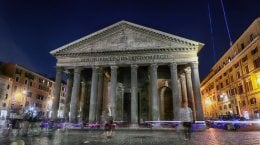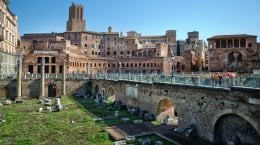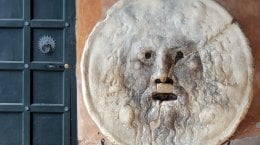Official Reseller Rome and Vatican – Jubilee 2025
Pantheon
The Pantheon is certainly one of the most important places of historical and artistic interest in the Italian capital. Visited every year by millions of tourists from all over the world, it is an example of a Roman temple – later voted a Christian basilica – very well preserved today.
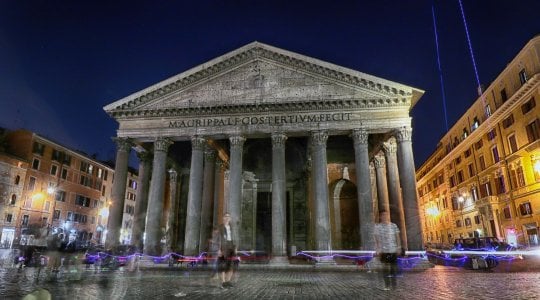
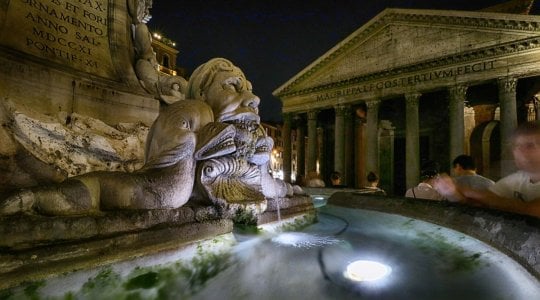
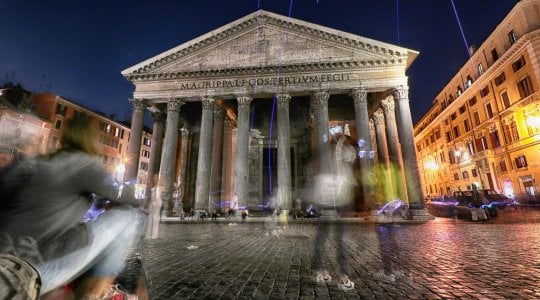
The Pantheon is certainly one of the most important places of historical and artistic interest in the Italian capital. Visited every year by millions of tourists from all over the world, it is an example of a Roman temple – later voted a Christian basilica – very well preserved today. The structure is located in the area now known as Neighborhood Pigna, in the historic center of the city, which can also boast other places of considerable cultural and artistic interest.
The term Pantheon comes from Greek but thanks to the writer Pliny the Elder – whose death occurred due to the eruption of Vesuvius, an event that made him famous – it was also adopted in the Roman language, and literally means “temple dedicated to all the gods”. Some historical findings testify indeed that in the various chapels placed around the perimeter of the structure there were statues of deities.
Today, instead, it is possible to observe the statues of the Emperor Augustus and his right-hand Agrippa.
But that’s not all, because the perfectly circular structure of the Pantheon, which is a masterpiece of engineering from ancient times, now also serves as an eternal dwelling place of very important personalities from a historical point of view for our country, including King Vittorio Emanuele II, King Umberto I and his wife Margherita di Savoia.
Built around B.C. 30, the temple suffered damage immediately upon completion, which was immediately repaired. From what emerged from the data handed down to modern times, the temple was initially conceived to have a rectangular plan. Only with the Emperor Hadrian, around A.D. 120, the Pantheon took the current layout, as it was almost completely rebuilt following a disastrous fire. In particular, the reconstruction that took place under Hadrian’s dominion took on a particular value from the artistic and architectural point of view, thanks to the search (and the achievement) of a perfect balance and an unprecedented stability.
The structure is currently anticipated by a pronaos that is raised above the square on which it overlooks (Piazza della Rotonda) and supported by 16 Corinthian columns. However, the noteworthy element of the Pantheon is certainly the interior, which has a perfectly circular plan.
Three-dimensionally, the temple has a cylindrical base, enclosed by a dome that takes the form of a hemisphere. The spasmodic search for perfection and balance – which has characterized all the Greek works and which was then handed down in Rome – has led to the creation of a temple that has a maximum height almost identical to the diameter of the base (equal to about 43 meters).
The apex of the dome is an element that greatly attracts attention, not only for its engineering peculiarity, but also because of legends and mystical stories that are related to it. The actual structure of the temple, in fact, has no windows, and the only connection with the external environment is (if we avoid considering the presence of the main door) the hole present in the dome, called the oculus, which is covered in lead.
There are many legends and curiosities related to the oculus of the Pantheon: Story goes that, for example, for some supernatural reason, the rain could not enter the temple through the hole. Other versions of the story justify this event with an enormous density of torches, whose heat directed towards the top caused the immediate evaporation of the drops of water. However, the legend finds its denial in the Pantheon itself, which presents a visible and articulated drainage system.
There is then another curiosity linked to the oculus: on April 21 (the date of the foundation of Rome), at exactly noon, a ray of sunshine crosses the hole and hits the entrance door, which is why the name of “solar temple” has been attributed to the temple.
The entrance of the light from that single hole present in the temple also explains the stylistic choices, in terms of materials (among which bronze and marble dominate) and colors, made by Adriano and his collaborators: the intention was to spread the lighting as much as possible, as well as creating spectacular plays of light and shadow.
The dome of the Pantheon, which is the largest in the world, is also the subject of a carefully studied optical effect. On its surface, in fact, it has lacunars, namely cavities, arranged in a circular way on five different levels. Each of these drawers is also composed of three large rectangles, which however are off-center (the intersections between the diagonals do not coincide). It is precisely this architectural choice that determines the optical effect: an observer placed under the oculus that looks upwards will have the feeling of being under a dome whose height is clearly above 43 meters.
The singular structure of the lacunars, therefore, has the precise objective of increasing the majesty of the temple.
The Pantheon is therefore an architectural masterpiece unique in the world, on the basis of which many other works have been realized.
Reaching it and visiting it is very simple, although it is located in the historic center. Obviously, the place is not easily accessible by car, due to the numerous ZTLs (traffic limited areas) and the almost total absence of parking areas, but is surrounded by several metro stations, placed at a modest distance. Among these, for example, it is possible to mention Roma Termini Station, which is about 2.5 km from the Pantheon, or Colosseo Metro Station, 1 km and a half away. Alternatively, you can take one of the buses that lead to Piazza Venezia, the Senate or Palazzo Chigi, which are not far from the temple. The most recommended choice, however, is to move on foot, as the area is teeming with monuments and places of interest. A few meters from the Pantheon, for example, there is the charming Piazza Navona, with its elegant staircase, as well as the Altare della Patria, the aforementioned Colosseum and the famous Trevi Fountain.
Another attraction that is not far from the Pantheon is the Wax Museum of Rome, with very faithful reproductions of prominent figures in today’s panorama.
Finally, if desired, departing from Piazza della Rotonda it is possible to reach Vatican City, which is just over 2 kilometers away, in which there is the famous St. Peter’s Basilica, with all the artistic works related to it.
Consult the stops of the Open Top Bus Vatican & Rome on the map, to find the closest stop to the attraction you are interested in visiting;
Alternatively, consult https://www.google.com/maps for information on public transport.
Vatican City
